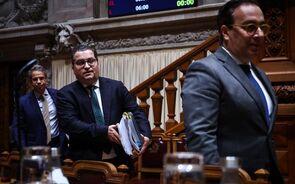Ontem vi as mãos ao Tio !!
2 mensagens
|Página 1 de 1
Plunge Protection Teams
Optimo artigo Cinzento. Obrigado por partilhares.
"Plunge Protection Teams" nao sao de agora. No livro Reminiscences of a Stock Operator, Edwin Lefevre estao referencias a Outubro de 1907 com uma situacao semelhante.
Para mim, que faco especulacao em Forex e numa altura que o EUR/USD parece querer quebrar os minimos do ano, e interessante confirmar que cada vez mais se fala de:
 White House is having trouble finding a replacement for Greenspan
White House is having trouble finding a replacement for Greenspan
 Housing bubble blowing out, oil prices exploding
Housing bubble blowing out, oil prices exploding
 Inflation blowing in
Inflation blowing in
 Twin deficits of trade and budget in the troposphere
Twin deficits of trade and budget in the troposphere
Mais uma vez obrigado por partilhares
Um abraco,
CN
"Plunge Protection Teams" nao sao de agora. No livro Reminiscences of a Stock Operator, Edwin Lefevre estao referencias a Outubro de 1907 com uma situacao semelhante.
Para mim, que faco especulacao em Forex e numa altura que o EUR/USD parece querer quebrar os minimos do ano, e interessante confirmar que cada vez mais se fala de:
Mais uma vez obrigado por partilhares
Um abraco,
CN
Ontem vi as mãos ao Tio !!
- Para mim isto faz algum sentido....não sei se ontem foi ou não assim como quem segura num pote de barro, porém hoje vejo um amento na volatilidade de 18%....enfim "" cenas"".
Asia Times, Hong Kong
Wednesday, October 19, 2005
From Japan Focus
John Embry and Andrew Hepburn provide a valuable entry into the world of finance. The two analysts illuminate the shadowy trail of the "Plunge Protection Team" in its apparent mission to rig the American stock markets.
Their account is backed up by considerable indirect evidence, as well as statements by credible insiders. If their account is correct, it means that US markets look a lot like the Japanese markets that were long derided for being subject to repeated official manipulation. A more important conclusion may be that US markets are even shakier than many believe. The trail that the two analysts follow is long, dating to just after Black Monday, October 19, 1987. On that day, the US stock market abruptly crashed. The Dow Jones average dropped by 508 points, to 1738. It threatened to do even worse the
next day when, after a brief rally, it went into reverse.
The markets seemed on the edge of a meltdown, but the abyss failed to open up. This lack of a meltdown has generally been attributed to the Federal Reserve Board's (FRB) steady hand and promises of liquidity. But sophisticated research on the events of those two days indicates that a sudden and unprecedented rise in the Major Market Index (MMI) sparked a recovery across the board. There is good reason to suspect that this recovery was the result of concentrated buying by a few firms.
It was after this crash that the President's Working Group on Financial Markets was put in place to prevent destabilizing declines. The Plunge Protection Team was intitutionalized in 1989 as a follow-up from this working group, and originally included the top public-sector financial authorities.
Its role was apparently tested with the Friday, October 13, 1989 stock crash. In this case, too, a sudden rush of aggressive buying of index futures contracts via the MMI saved the day. There appear to have been a considerable number of interventions in the wake of that, with the group expanding to include the heads of major banks.
Thus, for example, the markets after September 11, 2001, received a heavy dose of intervention. The need for this intervention was so great that its outlines emerged quite clearly in the press.
The Japanese, not surprisingly, appear to be part of the scheme as well. The authors show that there was plenty of consultation between Japanese financial authorities and their American counterparts in the lead-up to the Iraq War. There are also strong indications that the markets were not left unfettered to render their own verdict on the wisdom of the war, in the anxious days leading up to its outbreak.
There is abundant evidence adduced in the article. It is important to note that the authors are not against intervention per se. They note that letting plunging markets fix themselves could result in economic chaos. But they do warn that the secrecy and growing involvement of private-sector actors threatens to foster enormous moral hazards.
Major financial institutions may be acting as de facto agencies of the state, and thus not competing on a level playing field. There are signs that repeated intervention in recent years has corrupted the system.
This aggressive manipulation of the system took place on Alan Greenspan's watch as chairman of the FRB. The authors don't discuss the fact that Greenspan is to retire at the end of next January and the White House is having trouble finding a replacement in whom the markets will believe.
It may be that no credible candidate wants to take the baton from Greenspan at a time when it seems likely that the market will implode. Observers note that earlier changes of the FRB chair have generally been followed by much buffeting in the markets as they test the new maestro.
Market drops are common. Present risks include the American housing bubble blowing out, oil prices exploding, and inflation blowing in, at a time when the twin deficits of trade and budget are already in the troposphere.
This situation points to the likelihood that the Plunge Protection Team will be working overtime early next year
Asia Times, Hong Kong
Wednesday, October 19, 2005
From Japan Focus
John Embry and Andrew Hepburn provide a valuable entry into the world of finance. The two analysts illuminate the shadowy trail of the "Plunge Protection Team" in its apparent mission to rig the American stock markets.
Their account is backed up by considerable indirect evidence, as well as statements by credible insiders. If their account is correct, it means that US markets look a lot like the Japanese markets that were long derided for being subject to repeated official manipulation. A more important conclusion may be that US markets are even shakier than many believe. The trail that the two analysts follow is long, dating to just after Black Monday, October 19, 1987. On that day, the US stock market abruptly crashed. The Dow Jones average dropped by 508 points, to 1738. It threatened to do even worse the
next day when, after a brief rally, it went into reverse.
The markets seemed on the edge of a meltdown, but the abyss failed to open up. This lack of a meltdown has generally been attributed to the Federal Reserve Board's (FRB) steady hand and promises of liquidity. But sophisticated research on the events of those two days indicates that a sudden and unprecedented rise in the Major Market Index (MMI) sparked a recovery across the board. There is good reason to suspect that this recovery was the result of concentrated buying by a few firms.
It was after this crash that the President's Working Group on Financial Markets was put in place to prevent destabilizing declines. The Plunge Protection Team was intitutionalized in 1989 as a follow-up from this working group, and originally included the top public-sector financial authorities.
Its role was apparently tested with the Friday, October 13, 1989 stock crash. In this case, too, a sudden rush of aggressive buying of index futures contracts via the MMI saved the day. There appear to have been a considerable number of interventions in the wake of that, with the group expanding to include the heads of major banks.
Thus, for example, the markets after September 11, 2001, received a heavy dose of intervention. The need for this intervention was so great that its outlines emerged quite clearly in the press.
The Japanese, not surprisingly, appear to be part of the scheme as well. The authors show that there was plenty of consultation between Japanese financial authorities and their American counterparts in the lead-up to the Iraq War. There are also strong indications that the markets were not left unfettered to render their own verdict on the wisdom of the war, in the anxious days leading up to its outbreak.
There is abundant evidence adduced in the article. It is important to note that the authors are not against intervention per se. They note that letting plunging markets fix themselves could result in economic chaos. But they do warn that the secrecy and growing involvement of private-sector actors threatens to foster enormous moral hazards.
Major financial institutions may be acting as de facto agencies of the state, and thus not competing on a level playing field. There are signs that repeated intervention in recent years has corrupted the system.
This aggressive manipulation of the system took place on Alan Greenspan's watch as chairman of the FRB. The authors don't discuss the fact that Greenspan is to retire at the end of next January and the White House is having trouble finding a replacement in whom the markets will believe.
It may be that no credible candidate wants to take the baton from Greenspan at a time when it seems likely that the market will implode. Observers note that earlier changes of the FRB chair have generally been followed by much buffeting in the markets as they test the new maestro.
Market drops are common. Present risks include the American housing bubble blowing out, oil prices exploding, and inflation blowing in, at a time when the twin deficits of trade and budget are already in the troposphere.
This situation points to the likelihood that the Plunge Protection Team will be working overtime early next year
O dinheiro não é tudo !! Depois existe o ouro, a prata, joias, Ferraris....
2 mensagens
|Página 1 de 1


